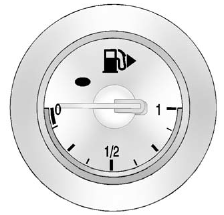Fuel Gauge

When the ignition is on, the fuel gauge tells you about how much fuel you have left in your tank.
An arrow on the fuel gauge indicates the side of the vehicle the fuel door is on.
When the fuel is low, a message may appear in the Driver Information Center (DIC), and a chime will sound. See Fuel System Messages for more information.
Here are four things that some owners ask about. None of these show a problem with your fuel gauge:
- At the service station, the fuel pump shuts off before the gauge reads full.
- It takes a little more or less fuel to fill up than the gauge indicated. For example, the gauge may have indicated the tank was half full, but it actually took a little more or less than half the tank's capacity to fill the tank.
- The gauge moves a little while turning a corner or speeding up.
- The gauge takes a few seconds to stabilize after the ignition is turned on, and will go back to empty when the ignition is turned off.
See also:
Parking on Hills
WARNING:
Parking the vehicle on a hill with the trailer
attached can be dangerous. If something goes
wrong, the rig could start to move. People can be
injured, and both the vehicle and the trai ...
Engine Oil Life System
The engine oil life system calculates engine oil life based on vehicle use and
displays the CHANGE ENGINE OIL SOON message when it is time to change the engine
oil and filter. The oil life system ...
Checking Things Underthe Hood
CAUTION:
Things that burn can get on hot engine
parts and start a fire. These include
liquids like fuel, oil, coolant, brake fluid,
windshield washer and other fluids, and
plastic or rubber. Yo ...


